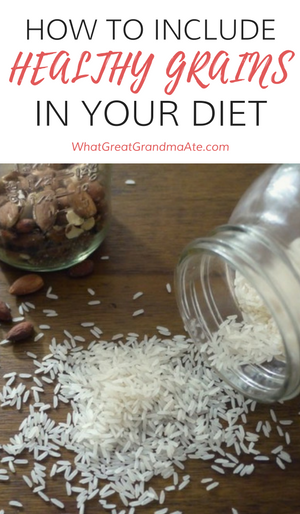This post may contain affiliate links. Please see our disclosure policy.
You can’t. There’s no such thing as “healthy grains.” STOP EATING THEM RIGHT NOW.
Just kidding. When I used to be strict Paleo, that’s what I believed. This isn’t completely true. I think one of the main reasons some people get turned off by the Paleo diet is its restriction on grains. However, there are ways to include them in our diet that are healthful and helpful.
What’s wrong with grains?
One of the reasons grains have gotten such a bad rap in the Paleo community is because most people cannot properly digest grains, as well as beans, nuts, seeds, and legumes. They all contain something called the phytic acid, which blocks the absorption of beneficial minerals in the body. Phytic acid is contained in the outer coating of grains, and no matter how healthy and mineral-rich your favorite beans are, you aren’t digesting its nutrients and benefits, and ingesting them can do you more harm than good.
In addition, most consumption of grains in the modern world are not in their whole, unrefined forms. Refined grains in bread, pasta, cereal, and chips are manmade concoctions and actually strip our bodies of our bodybuilding nutrients. This happens because these products are processed and are considered “empty carbs” without any nutritional value, and as we consume them, our bodies try to maintain its vitamin, mineral, and enzyme levels by pulling them from our own reserves. This leads to major deficiencies and digestion problems. It’s no wonder that we are getting sicker and sicker as a society when we still see grains on the bottom of the food pyramid and most of us are eating them in their highly refined states.
To make matters worse, regularly eating refined grains and high intake of carbohydrates spike up our blood sugar causing a surge in our insulin level, which attempts regulate the high glucose intake. With the sudden spike in insulin, our blood sugar dips again as our cells absorbs the glucose from the blood very quickly. The constant blood sugar roller coaster and depletion of nutrients that our modern diet puts us through contributes significantly to the spike in the rate of obesity, diabetes, allergies, and autoimmune diseases we see today.
So… what grains can I eat?
People say to me that we have been eating bread for about 10,000 years so it couldn’t be bad for us. You even see it in the Bible. But guess what? Consumption of grains has never been as high as today in our history, and our ancestors ate grains in their whole, complex forms that were properly prepared.
What does “properly prepared” mean? Traditional diets consisted of grains that were soaked, sprouted, and/or fermented. This process greatly increases the ability for us digest and absorb their nutrients by activating the phytase enzyme, which reduces the level of phytic acid. If you do not want to give up your grains, I recommend you purchase sprouted grains and flours at Whole Foods or natural grocery stores. You can even soak and sprout them at home. I do this with any kinds of raw nuts or grains I purchase and it makes a huge difference in my digestion.
If you are super lazy like me sometimes, jasmine or white rice is an exception to the rule. Jasmine and white rice have been milled and the outer layer has been stripped, so there is a very low amount of phytic acid that exists and they are easy on the digestion. Contrary to popular belief, while brown rice contains more nutrients, they are not readily available to the body because they contain a high level of phytic acid which negates their benefits once ingested. However, to include more variety in your grain intake and gain all the benefits, here’s how you can soak and sprouts grains, as well as beans, nuts, and seeds.
How to soak and sprout grains, beans, nuts, and seeds
1. Always use organic and raw grains, beans, nuts, and seeds.
2. In a glass jar, soak in water with 1 tbsp of apple cider vinegar. The amount of water should be about double the content you are soaking. The length of time varies, and you may need to change the water every 12 hours for longer soaking times. See the helpful guide above from http://wakeup-world.com/.
2. If only soaking, drain and cook as normally would. Soaking will shorten the cooking time for grains and beans. If you are soaking nuts or seeds, you can dehydrate them for 12 hours after, or keep them in the refrigerator and eat them slightly moist.
3. To sprout, drain and rinse. Place back in the jar and cover the jar with a cloth secured with a rubber band. In a dark area, place the jar on its side propped at an angle so the lid side is lower than the bottom of the jar. Place a bowl where the lid is so it can catch the water.
4. Rinse and drain every 12 hours while repeating step 3 for 1-5 days (refer again to the guide above for the length of time). When they are sprouted you’ll see small tails emerging at the end.
5. You can cook them immediately, store them in the refrigerator if you are using them in the next few days, or dehydrate them to make them last even longer. After dehydrating them, you can make sprouted flour by grinding them in the blender or food processor.
While it may seem like a lengthy process, it’s a necessary one if you want to gain the health benefits from these complex carbohydrates, and it ensures that you are digesting them properly. I also think that this keeps our intake in check. Refined grains are so easy access, which allows us to ingest them in way more quantity than we should. The traditional process of soaking and sprouting grains allows us to value these nutrients more, while helping us consume a more balanced ratio of this macronutrient.







